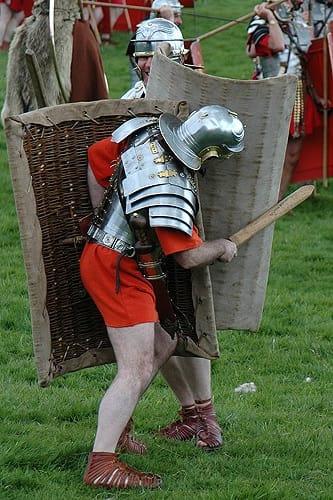Last Updated on December 18, 2021 by Vladimir Vulic
Marching and Physical Training
The first thing the soldiers were taught to do, was to march. The historian Vegetius tells us that it was seen as of greatest importance to the Roman army that its soldiers could march at speed.
Any army which would be split up by stragglers at the back or soldiers trundling along at differing speeds would be vulnerable to attack.
Hence right from the beginning the Roman soldier was trained to march in line and to keep the army a compact fighting unit on the move.
For this, we are told by Vegetius, during the summer months the soldiers were to be marched twenty Roman miles (18.4 miles/29.6 km), which had to be completed in five hours.
A further part of basic military training was also physical exercise. Vegetius mentions running, long and high jump and carrying heavy packs.
During the summer swimming was also a part of training. If their camp was near the sea, a lake or river, every recruit was made to swim.
Weapons Training
Next in line, after the training for marching and fitness, came the training of handling weapons.
For this they primarily used wickerwork shields and wooden swords. Both the shields and the swords were made to standards which made them twice as heavy as the original weapons. Evidently it was thought, that if a soldier could fight with these heavy dummy weapons, he would be twice as effective with the proper ones.

The dummy weapons were at first employed against heavy wooden stakes, about six foot high, rather than against fellow soldiers. Against these wooden stakes the soldier trained the various moves, strikes and counter-strikes with the sword.
Only once the recruits was deemed able enough in fighting against the stakes, were they assigned in pairs to train in individual combat.
This more advanced stage of combat training was called armatura, an expression which first was used in the gladiatorial schools, which proves that some of the methods used in training soldiers was indeed borrowed from the training techniques of gladiators.
The weapons used in the armatura were, though still of wood, of the same, or similar weight as the original service weapons.
Weapons training was deemed of such importance that weapons instructors generally received double rations, whereas soldiers who didn’t achieve adequate standards received inferior rations until they had proven in the presence of a high-ranking officer that they had attained the demanded standard. (inferior rations: Vegetius states that their wheat rations were substituted with barley)
After completing the initial training with the sword, the recruit was to master the use of the spear, the pilum. For this the wooden stakes were put to use again as targets. The pilum used for practice was, once again, twice the weight of the regular weapon.
Vegetius notes that weapons training was given such importance that in some places roofed riding schools and drill halls were built to allow for training to continue throughout the winter.

Historian Franco Cavazzi dedicated hundreds of hours of his life to creating this website, roman-empire.net as a trove of educational material on this fascinating period of history. His work has been cited in a number of textbooks on the Roman Empire and mentioned on numerous publications such as the New York Times, PBS, The Guardian, and many more.
